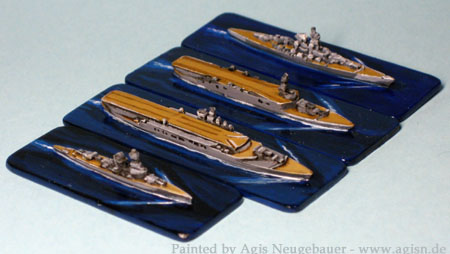|
The Z-Plan was Germany’s fleet building program started shortly before World War 2. In the mid 1930s a major discussion about a new fleet program started in Germany. There were two strong opinions as to what kind of program should be chosen. One plan was focused on a large submarine fleet and a relatively small surface fleet for coastal protection, this plan was preferred by the U-Boat faction in the Kriegsmarine command. The other alternative was a mixed fleet of various surface ships and a much smaller U-Boat fleet, quite similar to the Imperial Navy in World War I or the British Royal Navy. In the end, this plan was chosen as the new fleet building program, after several modifications it was called the "Z-Plan".
According to this plan, the German Kriegsmarine would have grown to about 800 units, centred on:
- 13 battleships and battle cruisers,
- 4 aircraft carriers,
- 15 Panzerschiffe,
- 23 cruisers and
- 22 so called "Spähkreuzer" which were basically large destroyers.
These ships would have been built between 1939 and 1946, and in this time, the personal of the Kriegsmarine would have grown to 201,000 men and over 33 billion Reichsmark would have been spent building these new units.
This project was never really based in reality. It was highly unlikely that the German industry would have had the resources for such a construction program and equally unlikely that the other European Nations would have stood still and not react to this program. The realisation of the Z-Plan started on January 29th, 1939, when two H-Class battleships were laid down. Three months later Germany quit the fleet treaty with England and the dream of "No more war against Britain" was gone. Four months later Germany attacked Poland and work on all Z-Plan projects was suspended. Within a few months, all incomplete ships of the Z-Plan were scrapped and the material used to build additional submarines.
O,P,Q-Class Battlecruiser (Schlachtkreuzer)
In addition to the battleships of the H-Class, a group of 12 new armoured ships (Kreuzer P), successors to the famous Admiral Graf Spee, Admiral Scheer and Lützow, were part of the Z-Plan. The design studies for the three battlecruisers of the O-class (Schlachtkreuzer O, Schlachtkreuzer P, Schlachtkreuzer Q) were simultaneous started to those of the new Panzerschiff design (Kreuzer P ) in 1937. In 1939 an option was explored to replace the three existing Panzerschiffe with the same number of new battle-cruisers. Construction orders were given to Deutsche Werke, Kiel, and the Kriegsmarinewerft in Wilhelmshaven and the Germaniawerft in Kiel in the same year, but none of the ships were started.
These ships were planed with the idea of commerce war in mind. Therefore, they would get a mixed propulsion system, diesel engines for long range medium speed cruising and additional turbines for high speed combat ac-tion. The main role of these battlecruisers was to engage enemy convoys and destroy transports and cargo ships. However, unlike the heavily protected H-Class battleships, these battlecruisers had armour protection only slightly better to that of a cruiser. So it's very doubtful that one of these ships would have been able to attack a well protected allied convoy.
The model below is a highly modified (see Hyperdetailing) 1/2400 scale model by “Panzerschiffe”.
Please note: All markings used, such as the swastikas, are displayed ONLY for historical accuracy and should not be considered as an attempt to glorify war or Nazism. The symbols do not signify or represent my own personal political opinion.
P-Class Cruiser (Panzerschiff)
In 1938 the first design studies for a Panzerschiff successor were made. The new Panzerschiff was called Kreuzer P, its specifications showed a bigger, faster and better protected version of the original design. In many respects it was a modification of the design of the Panzerschiff D and Panzerschiff E, the planned successors of the Deutschland class which were later modified to Scharnhorst and Gneisenau. As these ships were intended to be used for commerce war, they were designed to be superior to a heavy cruiser, in terms of artillery and faster than existing battleships.
It was planed to lay down four of these ships per year, starting in 1939 so that the complete Z-Plan battle fleet would be operational by 1947. The first three of these ships would get the 28 cm (11") turrets removed from the Scharnhorst and Gneisenau during their conversion to 38 cm (15") guns. However, by 1939 it was obvious that the Scharnhorst and Gneisenau conversion could not be completed by 1941/42, when it was originally scheduled. Therefore, three of the planed Kreuzer P would be modified to get 38 cm turrets which were already in production, resulting in the battle cruiser O-Class.
Although the ships were already assigned to shipyards, none of the Kreuzer P was ever ordered because of the start of World War 2.
The model below is a highly modified (see Hyperdetailing) 1/2400 scale model by “Panzerschiffe”.
Please note: All markings used, such as the swastikas, are displayed ONLY for historical accuracy and should not be considered as an attempt to glorify war or Nazism. The symbols do not signify or represent my own personal political opinion.
Grossflugzeugkreuzer / Flugdeckkreuzer
During 1942, the idea of a hybrid warship appeared in the constructions department of the Kriegsmarine. The idea was to build a ship that could provide both, air cover for Kriegsmarine units and still be usable for conventional commerce raiding. A combination of an aircraft carrier and a cruiser/battleship was thought to be a solution for this task. Although the project never had a high priority and never came close to realisation, several design studies were made. Two different types of ships were examined, a battleship sized "Grossflugzeugkreuzer" (Project A) and a cruiser sized "Flugdeckkreuzer" (Project E).
The models below are 1/6000 Magister Militum models.

|

